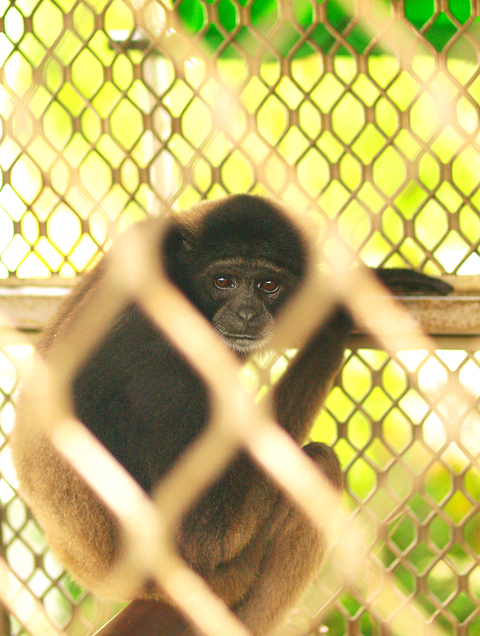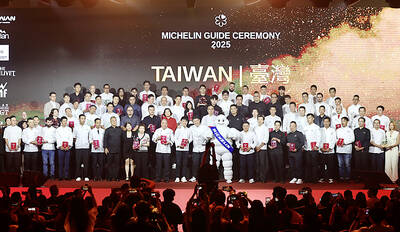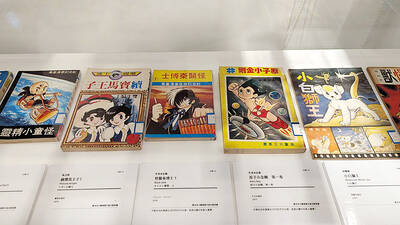A city councilor yesterday condemned the Taipei City Government for abusing two gibbons that have remained caged in the Chang Ta-chien (張大千) museum for 19 years since the artist passed away.
The two gibbons, which were gifts to the museum in 1991, have been kept in a cage measuring 3m long, 1m wide and 3m high for 19 years, Democratic Progressive Party (DPP) Taipei City Councilor Chou Wei-you (周威佑) said.
“The museum nurtured the gibbons to represent Chang’s love for the animal, but kept them in the small cage. It’s animal abuse, and the city government has a responsibility to solve the problem,” he said.

PHOTO: CNA
The former residence of Chang was declared a municipal monument in 2008 by the city’s Department of Cultural Affairs for its cultural and historical significance in representing the painter’s taste and lifestyle.
Chang raised three gibbons during his lifetime. Museum manager Tu Lu-rong (杜祿榮) said the museum kept the two gibbons in the residence to represent the late painter’s love for gibbons.
He acknowledged that the cage was too cramped for the gibbons and said the museum was willing to move them to Taipei Zoo so they could enjoy a better environment as space at the museum was limited.
Chao Ming-chieh (趙明杰), a division chief at the zoo, said it would be better to improve the living quarters for the animals at the museum as the two gibbons, both 25 years old, were too old to adapt to a new environment.
Tu said the museum was a municipal monument, and any reconstruction would have to be approved by the department.
The department said it would hold a meeting and discuss the issue with the museum and the zoo before finalizing a plan for the animals within two weeks.
The two-story residence, also known as “the Abode of Maya,” was designed by Chang and completed in 1978. Chang’s family donated the residence on Zhi-shan Road to the National Palace Museum following his death in 1983.
The museum converted it into a memorial to the artist, with everything in the residence preserved as it was during his lifetime.

Eight restaurants in Taiwan yesterday secured a one-star rating from the Michelin Guide Taiwan for the first time, while three one-star restaurants from last year’s edition were promoted to two stars. Forty-three restaurants were awarded one star this year, including 34 in Taipei, five in Taichung and four in Kaohsiung. Hosu (好嶼), Chuan Ya (川雅), Sushi Kajin (鮨嘉仁), aMaze (心宴), La Vie by Thomas Buhner, Yuan Yi (元一) and Frassi in Taipei and Front House (方蒔) in Kaohsiung received a one-star rating for the first time. Hosu is known for innovative Taiwanese dishes, while Chuan Ya serves Sichuan cuisine and aMaze specializes

Taitung County is to launch charter flights to Malaysia at the end of this year, after setting up flights to Vietnam and Thailand, the Taitung County Government said yesterday. The new charter flight services, provided by low-cost carrier Batik Air Malaysia, would be part of five-day tour packages for visits to Taitung County or Malaysia. The Batik Air charter flight, with about 200 seats, would take Malaysian tourists to Taitung on Dec. 30 and then at 12:35pm return to Kuala Lumpur with Taiwanese tourists. Another charter flight would bring the Taiwanese home on Jan. 3 next year, arriving at 5:30pm, before taking the

Taiwan High Speed Rail Corp. (THSRC) plans to ease strained capacity during peak hours by introducing new fare rules restricting passengers traveling without reserved seats in 2026, company Chairman Shih Che (史哲) said Wednesday. THSRC needs to tackle its capacity issue because there have been several occasions where passengers holding tickets with reserved seats did not make it onto their train in stations packed with individuals traveling without a reserved seat, Shih told reporters in a joint interview in Taipei. Non-reserved seats allow travelers maximum flexibility, but it has led to issues relating to quality of service and safety concerns, especially during

An exhibition celebrating Taiwan and Japan’s comic culture opened on Saturday in Taichung, featuring a section that explores Taiwanese reproductions of Japanese comics from when martial law limited Japanese representation. “A Century of Manga Culture: An Encounter of Taiwan and Japan’s Youth” held its Taiwan opening ceremony at Taichung’s National Taiwan Museum of Comics after an initial one-month run in Japan’s Kyoto International Manga Museum between May 24 and June 24. Much like the Kyoto exhibition, the show mainly celebrates the comic connection between Taiwan and Japan through late Taiwanese comic book